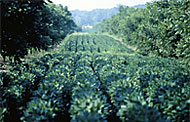-1.jpg)
Featured Seminar
Riparian Forest Buffers in the Developed Landscape
MIke Dosskey, a research riparian ecologist with the USDA National Agroforestry Center, gave a briefing Feb. 14, 2012, on new research and design of riparian forest buffers. Listen here![]() or click on the pdf below to view a Powerpoint in pdf format.
or click on the pdf below to view a Powerpoint in pdf format.
Research Projects
NAC Research places emphasis on providing a scientific basis for developing agroforestry on crop, range, and pasture lands in the central U.S. Tree-based buffers can improve water quality, enhance crop and livestock production, create wildlife habitat, and sequester carbon, among other benefits for private landowners and communities.
- Ecological Functions of Buffers to understand how riparian and upland tree buffers protect water quality, enhance aquatic and terrestrial environments, and sequester carbon.
- Site Design and Management to determine how to design and manage individual buffers to attain desired production and conservation benefits.
- Landscape Integration to develop an improved basis for decision-making relative to design criteria and expected water quality benefits, along with other resource considerations, from tree-based buffer systems.

